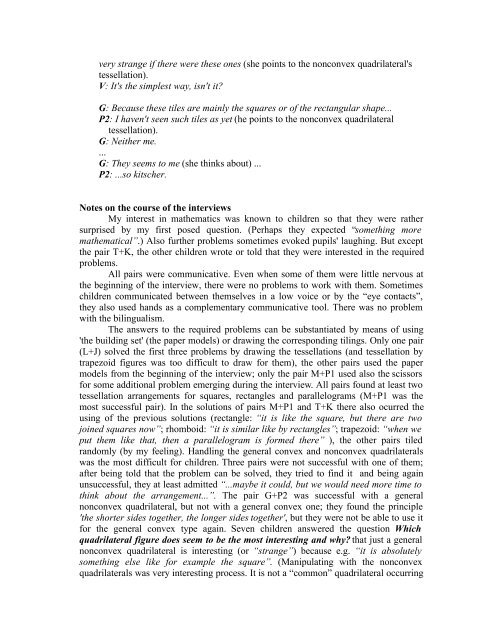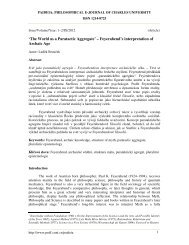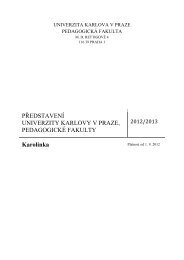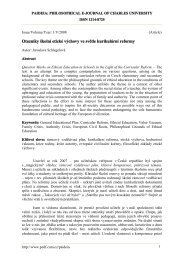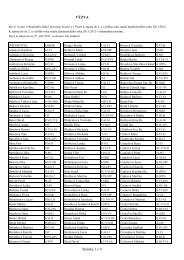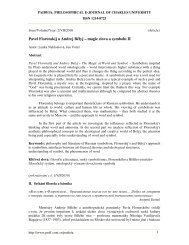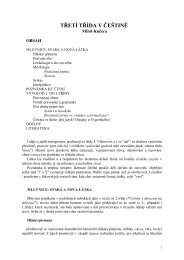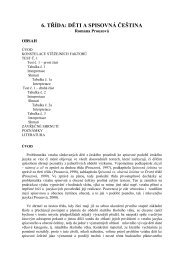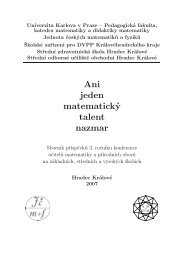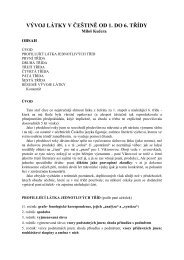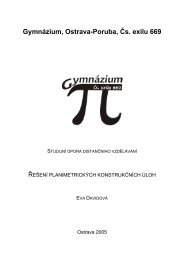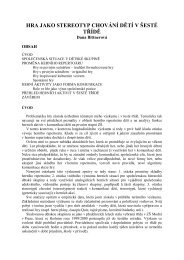Tessellations by Polygons in Mathematics Education
Tessellations by Polygons in Mathematics Education
Tessellations by Polygons in Mathematics Education
Create successful ePaper yourself
Turn your PDF publications into a flip-book with our unique Google optimized e-Paper software.
very strange if there were these ones (she po<strong>in</strong>ts to the nonconvex quadrilateral's<br />
tessellation).<br />
V: It's the simplest way, isn't it?<br />
G: Because these tiles are ma<strong>in</strong>ly the squares or of the rectangular shape...<br />
P2: I haven't seen such tiles as yet (he po<strong>in</strong>ts to the nonconvex quadrilateral<br />
tessellation).<br />
G: Neither me.<br />
...<br />
G: They seems to me (she th<strong>in</strong>ks about) ...<br />
P2: ...so kitscher.<br />
Notes on the course of the <strong>in</strong>terviews<br />
My <strong>in</strong>terest <strong>in</strong> mathematics was known to children so that they were rather<br />
surprised <strong>by</strong> my first posed question. (Perhaps they expected “someth<strong>in</strong>g more<br />
mathematical”.) Also further problems sometimes evoked pupils' laugh<strong>in</strong>g. But except<br />
the pair T+K, the other children wrote or told that they were <strong>in</strong>terested <strong>in</strong> the required<br />
problems.<br />
All pairs were communicative. Even when some of them were little nervous at<br />
the beg<strong>in</strong>n<strong>in</strong>g of the <strong>in</strong>terview, there were no problems to work with them. Sometimes<br />
children communicated between themselves <strong>in</strong> a low voice or <strong>by</strong> the “eye contacts”,<br />
they also used hands as a complementary communicative tool. There was no problem<br />
with the bil<strong>in</strong>gualism.<br />
The answers to the required problems can be substantiated <strong>by</strong> means of us<strong>in</strong>g<br />
'the build<strong>in</strong>g set' (the paper models) or draw<strong>in</strong>g the correspond<strong>in</strong>g til<strong>in</strong>gs. Only one pair<br />
(L+J) solved the first three problems <strong>by</strong> draw<strong>in</strong>g the tessellations (and tessellation <strong>by</strong><br />
trapezoid figures was too difficult to draw for them), the other pairs used the paper<br />
models from the beg<strong>in</strong>n<strong>in</strong>g of the <strong>in</strong>terview; only the pair M+P1 used also the scissors<br />
for some additional problem emerg<strong>in</strong>g dur<strong>in</strong>g the <strong>in</strong>terview. All pairs found at least two<br />
tessellation arrangements for squares, rectangles and parallelograms (M+P1 was the<br />
most successful pair). In the solutions of pairs M+P1 and T+K there also ocurred the<br />
us<strong>in</strong>g of the previous solutions (rectangle: “it is like the square, but there are two<br />
jo<strong>in</strong>ed squares now”; rhomboid: “it is similar like <strong>by</strong> rectangles”; trapezoid: “when we<br />
put them like that, then a parallelogram is formed there” ), the other pairs tiled<br />
randomly (<strong>by</strong> my feel<strong>in</strong>g). Handl<strong>in</strong>g the general convex and nonconvex quadrilaterals<br />
was the most difficult for children. Three pairs were not successful with one of them;<br />
after be<strong>in</strong>g told that the problem can be solved, they tried to f<strong>in</strong>d it and be<strong>in</strong>g aga<strong>in</strong><br />
unsuccessful, they at least admitted “...maybe it could, but we would need more time to<br />
th<strong>in</strong>k about the arrangement...”. The pair G+P2 was successful with a general<br />
nonconvex quadrilateral, but not with a general convex one; they found the pr<strong>in</strong>ciple<br />
'the shorter sides together, the longer sides together', but they were not be able to use it<br />
for the general convex type aga<strong>in</strong>. Seven children answered the question Which<br />
quadrilateral figure does seem to be the most <strong>in</strong>terest<strong>in</strong>g and why? that just a general<br />
nonconvex quadrilateral is <strong>in</strong>terest<strong>in</strong>g (or “strange”) because e.g. “it is absolutely<br />
someth<strong>in</strong>g else like for example the square”. (Manipulat<strong>in</strong>g with the nonconvex<br />
quadrilaterals was very <strong>in</strong>terest<strong>in</strong>g process. It is not a “common” quadrilateral occurr<strong>in</strong>g


